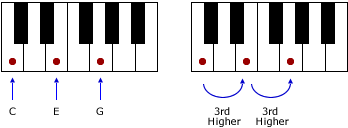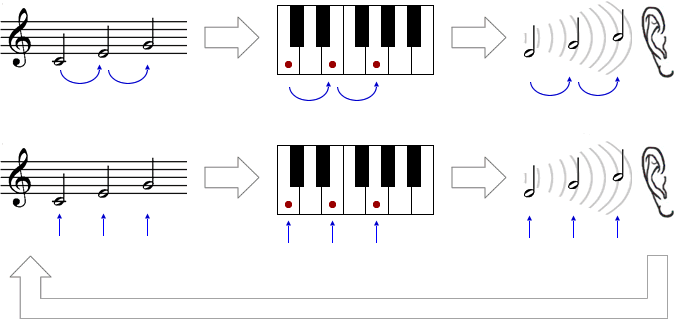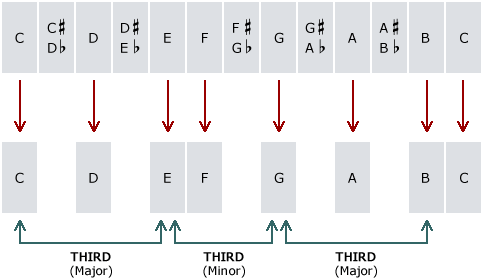Clearly a music notation system should make it easy to identify individual notes. This tutorial discusses why it is also important to make it easy to identify intervals as well. For example, playing by ear, improvising, and transposing all rely on hearing the intervals in music, but traditional music notation hinders the identification of intervals. Alternative notation systems can solve this problem. This tutorial is part of a series that includes Intervals in Traditional Music Notation and Intervals in 6-6 Music Notation Systems.
Reading Music by Individual Notes and by Intervals

There are two basic ways to read music — by individual notes and by intervals (i.e. by absolute orientation and by relative orientation). We tend to think of reading music in terms of identifying notes by their position on the staff, which is the way beginners are usually taught. The staff functions like a map with each vertical position corresponding to a particular note name.
Music can also be read by recognizing the intervals between notes, regardless of their note names. In this case the staff functions like a ruler or measuring tape that helps us to see the distances between notes which indicates their interval relationship. This goes for both melodic intervals and harmonic intervals (notes played both sequentially and simultaneously).
Usually musicians are not consciously thinking of the names of each note or each interval as they play (which would take too much time). They are just reading a note or an interval on the staff and directly playing it on their instrument. The visual notation is translated directly into a habitual muscle movement.
Musicians may rely on both of these two types of reading when playing, so discussing them as separate processes is somewhat artificial and only for conceptual clarity. The main point is that they are both useful and complement each other, so it is important to consider both of them when assessing a music notation system. This is partly because they correspond to two ways of playing an instrument.
Before moving on, note that reading by interval is only possible to a limited extent in traditional music notation. While it is easy to see that the notes shown above are a third apart, whether they are a major third or a minor third apart is not apparent from their appearance alone. We will return to this in the last section of this tutorial.
Playing Music by Individual Notes and by Intervals


Instruments can also be played in these two ways — by individual notes and by intervals (i.e. by absolute orientation and by relative orientation). The images above illustrate these two ways of playing on a piano keyboard and on a guitar fretboard.
Given enough practice most instruments can be played in either way, but some instruments lend themselves to being played in one way or the other. The piano is easier to play by individual notes and harder to play by interval, due to the irregular key layout. The more regular pitch layout of string instruments and isomorphic instruments make them easier to play by interval. (Note how the difference between the major and minor third shown above is clearer on the guitar fretboard than on the keyboard.) When it comes to singing it is generally easier to sing by interval than by individual notes (unless you have “perfect pitch” or “absolute pitch”).
There is a complementary relationship between the way one reads and plays music. The way one plays will tend to follow the way one reads. If I read a note (“F”) then I will need to know how to play that note on my instrument. If I read an interval (“a third higher than the previous note”) then I will need to know how to play that interval.[1]
As I read and play by notes or by intervals, and I hear those notes or intervals, I will be learning both the staff and my instrument in terms of either notes or intervals, in a process of repetition and reinforcement. In short, I will be learning to read, play, and hear by notes or by intervals.

If a notation system makes individual notes easy to identify and/or intervals easy to recognize then it will facilitate reading and playing by individual notes and/or by intervals. Conversely, if a notation system makes either of these types of reading more difficult, it will make the corresponding type of playing more difficult to learn.
Our tutorial on Intervals in Traditional Music Notation discusses how traditional music notation makes it difficult to perceive intervals because it does not represent them clearly, consistently, or directly. It also makes both intervals and individual notes harder to read through its use of clefs, key signatures, and accidental signs. The impact of these aspects of traditional notation on how one reads music will also affect how one learns to play an instrument.

Hearing Music by Individual Notes and by Intervals
These two ways of reading and playing also correspond to two ways of hearing music. Notes can be heard absolutely as individual notes or relatively in terms of their interval relationships to surrounding notes.
Relatively few people have what is known as “perfect pitch” or “absolute pitch,” the ability to hear individual notes, completely out of context, and identify them by name. However, most people do have what is known as “relative pitch,” the ability to hear notes relatively, in terms of their interval relationships with other notes. This allows them to recognize a familiar melody regardless of the key in which it is played. What they are hearing and recognizing is the consistent pattern of intervals between the notes (together with the rhythm of the notes).
Because most people hear music by relative pitch (i.e. interval relationships) it makes sense for a notation system to support reading by intervals, by making intervals easy to recognize. This allows for an intuitive correspondence between how people hear music and the way they read and play it. On the other hand, a notation system that makes it harder to read by intervals leads to a certain disconnect or mismatch between how music is heard (interval relationships) and how it is read and played (individual notes). This is also closely related to improvising and playing by ear.
Playing by Ear and Improvising

Playing by ear, improvising, and transposing by sight are skills that involve hearing and playing by intervals and understanding music in terms of intervals. Learning to play by interval when reading notation will make it easier to play the interval patterns you hear or come up with in your head when playing by ear or improvising. If a notation system makes it easier to read and play by intervals then this will help you learn these skills.
Often those who play by ear do not read music and those that read music may not be able to play by ear. Perhaps part of the reason is that the traditional notation system does not fully support reading by interval? Next we will take a closer look at the limited support for reading by intervals in traditional notation.
Reading by Intervals in Traditional Notation
As discussed in our tutorial on Intervals in Traditional Music Notation, the traditional system makes it difficult to fully perceive the intervals between notes: what you see does not consistently correspond with what you hear. This imperfect correspondence makes it harder to read and play by interval, to understand music in terms of intervals, or even to be aware of the intervals that you are playing when reading and playing by individual notes. Nevertheless, a certain limited form of reading by interval is still possible in traditional notation.
On a traditional diatonic staff, it is directly apparent that an interval is either a second, third, fourth, fifth, sixth, seventh, octave, etc. In music theory this is known as the interval’s name. However, an interval’s appearance does not directly reveal its quality:major, minor, perfect, augmented, or diminished.
This imprecision in the representation of intervals restricts the possibilities for reading and playing by intervals. For example, it is not much help to know that you need to play a third, if you do not also know whether it is a major third (4 semitones) or minor third (3 semitones).

To extend this example, it is easy to see that the notes on the staff above are ascending by thirds. However, to fully identify them and know whether to play a major or minor third, you have to know the identity of the individual notes, as determined by the clef sign, key signature, and any accidentals. Since you have to know the individual notes in order to know what kind of interval to play, it appears that reading by interval depends upon reading by individual notes and is subordinated to it.

However, there is more to the story. Imagine reading and playing music in the key of C (with no accidental notes) on an instrument that can only play notes in the key of C (like a recorder, a harmonica, or a piano without any black keys). That means that you will only be playing notes within the set of diatonic notes of the given key, both on the staff and on your instrument. (The traditional staff was originally invented for just these types of instruments and music — those that are limited to the diatonic notes in one key.)
Given those constraints, you only need to know an interval’s name (second, third, etc.) in order to play it correctly. The quality of the interval (major, minor, etc.) will be “automatically” determined by the set of diatonic notes in the current key. Starting from any given note there will only be one possible quality for each second, third, fourth, etc. that you could play. For example, a third that starts on the first/tonic note in a major key will always be a major third (C to E in the key of C), and a third that starts on the third note of the key will always be a minor third (E to G).

What about music that contains “accidental” notes, chromatic alterations that fall outside of the key? These accidental notes will also fall outside of the scope of this limited system of reading by interval. Accidental signs affect an interval’s quality (not its name), and only an interval’s name is apparent from its direct visual appearance on the staff (not its quality). At best an interval that contains one or more accidental notes could be read as an alteration of another interval, but it could not be read directly as an interval in itself (as it could be on a chromatic staff).
So this is the limited form of reading by interval that is possible in traditional notation — reading intervals only by name but not by quality. It depends on musicians having already achieved fluency with reading and playing in any given key. They must have already internalized the set of diatonic notes that are represented by the staff for a given key, which entails memorizing all of the key signatures and constantly keeping the current key signature in mind when reading music.
For instruments that can play all twelve chromatic notes per octave, the musician must learn to limit himself or herself to only the notes in the current key. That entails memorizing the notes in each key and internalizing them through practice. This is probably one reason that practicing scales is emphasized so much. It is only by ingraining major and minor scales in their fingers and minds that musicians can begin to be able to read by interval.
In short, with traditional notation, reading by interval in any key becomes accessible only after a significant amount of memorization and practice, and even then it is only possible to a limited extent. This effectively prevents reading by interval from being part of the early learning process.
How different would it be if reading by interval was fully accessible, and easy to do, in any key, right from the start? Instead of rote memorization of key signatures and diatonic scales (without a notation system that clearly shows the consistent interval patterns found in these scales and keys), musicians could easily learn these keys, scales, and interval patterns by seeing these patterns directly in the music as they learned to read and play it. (Of course, it will always pay to practice your scales…)
For examples of how some chromatic notation systems make it easy to read by intervals, see our next tutorial, Intervals in 6-6 Music Notation Systems.
[1] While one could read notes by their names and then mentally translate them into intervals in order to play the intervals (or vice-versa), it would be simpler to avoid this extra step of translation. So one’s mode of playing will tend to follow and depend upon one’s mode of reading.